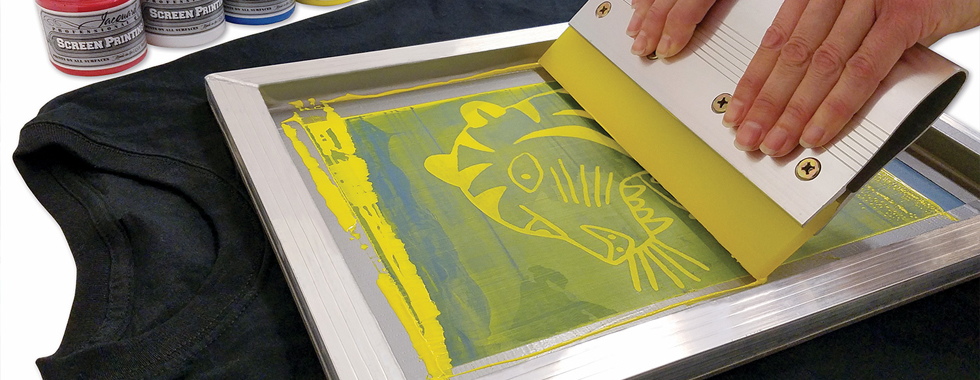The Important Guide to Recognizing Screen Printing and Its Versatile Uses
Screen printing has an abundant background that goes back to ancient times, evolving right into an advanced strategy utilized throughout different industries today. This guide explores the intricacies of the screen printing procedure, outlining its applications in style, home, and advertising decoration - 10:9 Design Embroidery. Recognizing these basics can open creative possibility for both artistic and industrial jobs. The complying with areas will certainly disclose necessary suggestions and strategies to enhance one's screen printing endeavors
The History of Screen Printing
Although screen printing has roots that map back centuries, its advancement reflects the artistic and technological developments of various cultures. Stemming in ancient China, the technique was at first used for embellishing fabrics and later infect Japan, where it came to be important to Ukiyo-e woodblock printing. The technique changed to Europe in the 18th century, where it acquired popularity among artisans and commercial printers. The invention of picture solution in the 20th century changed screen printing, enabling even more intricate styles and greater efficiency. Artists like Andy Warhol even more propelled its appeal, utilizing the tool to create famous works that combined commercialism and fine art. By the late 20th century, screen printing had developed itself as a functional method, utilized in fashion, advertising and marketing, and great art. Today, it remains to progress, incorporating digital innovation and expanding its applications throughout different industries.
The Screen Printing Refine Explained
Screen printing changes imaginative visions into substantial layouts through a collection of precise steps. Originally, a photo is created and after that moved onto a screen, commonly made from fine mesh fabric stretched over a frame. A light-sensitive solution is applied to the screen, which is revealed to light, hardening in areas not covered by the photo. After rinsing the unhardened emulsion, a stencil is developed.
Next off, the screen is positioned over the substratum, whether it be textile, paper, or another material. Ink is after that pressed via the open areas of the pattern utilizing a squeegee, transferring the style onto the substrate listed below. This process can be duplicated for multiple shades, calling for separate displays for every tone. The published item is cured using warm to assure the ink sticks properly, resulting in a durable, vibrant style prepared for usage.
Kinds Of Screen Printing Techniques

In addition, specialty techniques, such as discharge screen printing, get rid of dye from the fabric to produce softer prints, while foil screen printing applies metallic aluminum foil to achieve a shiny surface (10:9 Design reviews). Each technique provides distinct characteristics, dealing with numerous innovative demands and manufacturing ranges, inevitably increasing the opportunities within the screen printing domain name
Applications of Screen Printing in Numerous Industries

Additionally, the signs and advertising fields utilize screen printing for developing appealing screens and banners. This approach permits bold colors and detailed designs that catch interest. In electronic devices, screen printing is used for using conductive inks to circuit card, essential for element links. The home design market accepts screen printing to generate unique designs on fabrics and wall surface art. Overall, screen printing offers as a critical device across varied areas, improving items with customized and visually appealing graphics.
Tips for Successful Screen Printing Projects
While taking on a screen printing job, mindful attention to detail can significantly improve the final result. Initially, choosing premium products is necessary; this includes the screen, inks, and substrates. Making use of ideal mesh matters can affect ink deposition and detail resolution. Prep work is equally essential; thorough cleaning of displays and appropriate exposure times assure crisp prints.
Next off, exact enrollment is essential for multi-color prints. Using alignment devices can aid accomplish specific layering. Additionally, testing prints on scrap products prior imp source to manufacturing helps determine prospective issues without wasting sources.

Frequently Asked Questions
What Materials Are Ideal for Screen Printing on Textile?
Cotton and polyester blends are optimal for screen printing on material as a result of their sturdiness and ink absorption. Furthermore, specialized fabrics like silk or canvas can generate special structures and coatings, boosting the overall style top quality.
Just how Do I Clean and Maintain Screen Printing Tools?
To maintain and clean up screen printing tools, one should on a regular basis clean displays with ideal solvents, inspect squeegees for wear, oil moving components, and store all items in a completely dry, dust-free environment to prolong their lifespan.
What Are the Environmental Effects of Screen Printing?
Screen printing can have substantial ecological effects, consisting of chemical waste from inks and solvents, water use during cleansing processes, and energy consumption. Sustainable practices and green products are essential for decreasing these adverse results.
Can Screen Printing Be Done at Home Successfully?
Screen printing important site can be successfully done at home with the best materials and methods. Enthusiasts can develop top quality prints, though success relies on their ability degree, devices, and understanding of the procedure included.
What Are the Expenses Connected With Starting a Screen Printing Business?

Beginning a screen printing organization includes costs for devices, materials, and workspace. First expenses generally range from a few hundred to several thousand dollars, depending upon the scale, quality of machinery, and desired production ability.
Screen printing has a rich background that dates back to ancient times, developing into an innovative technique utilized throughout different sectors today. One more method, rotary screen printing, employs round displays, promoting continuous printing on textile rolls, therefore boosting performance for large manufacturings. Furthermore, specialized strategies, such as discharge screen printing, get rid of dye from the fabric to produce softer prints, while aluminum foil screen printing applies metal aluminum foil to accomplish a glossy finish. In the fashion industry, screen printing is commonly utilized to create vibrant styles on clothing, allowing brands to showcase their unique designs. Cotton and polyester blends are perfect for screen printing on material due to their toughness and ink absorption.